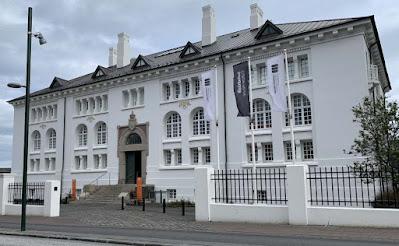
Wax figure at the Saga Museum, Reykjavik, Iceland.
My friend Caroline Hatton, a children’s writer and frequent contributor to this blog, visited a few museums in Reykjavik and took the photos in this post in June 2023.
While in downtown Reykjavik for three days, I didn’t buy a City Card (24-, 48- or 72-hour pass to buses, hot pools, and some museums) because it would have cost more than the few admission tickets I wanted. Here are glimpses of the museums I visited.
THE SAGA MUSEUM
The Saga Museum is about Icelandic history, simply because that’s what the Icelandic Sagas are about. They are family oral histories written down a few centuries after the events they document. I loved the two I had read previously, Njáls’ Saga and the Saga of Erik the Red.
The museum contains no historical artefacts, only exquisite, life-like, costumed wax figures (photo above) posed in key historic scenes. I enjoyed feasting my eyes on them while reading the chronological info panels, the entire content of which is at the museum website (above link, “Overview” button).
Having recently picked which saga to read next, namely Egil’s Saga, I was glad to hear the audio guide pronounce the name: like ey-yee-tl and said quickly and briefly with barely any T and L sound. Not an easy name to yell at a naughty boy. Not an easy boy to handle. Big for his age. The first person he killed, when he was seven years old, was an older playmate who annoyed him. I can’t wait to read about what he did as a grown Viking. The only other thing I already know about him is that he was a precocious, gifted, mesmerizing poet.
In the museum play area full of costumes and toy weapons, I gratefully noted the absence of horned helmets, because contrary to common belief, the Vikings did not wear such. My visit ended with the obligatory gift shop browsing, but no purchase.
THE SETTLEMENT EXHIBITION

The Settlement Exhibition building.
Located in one of the many corrugated-iron-clad buildings in an old part of Reykjavik, The Settlement Exhibition begins chronologically on the bottom floor, with archeological remains from the time when Vikings first settled in Iceland, in the local area. Discovered in 2001, the base of the stone wall of a 10th-century Viking longhouse (a home for an extended family) was left where it was found. It is now surrounded by excellent displays which paint a picture of what life was like at the early settlers’ farm on the shore of the bay.

Model of 1906 Reykjavik.
The museum’s upper floors present the development of Reykjavik from a farm to a city. Because I love miniatures, my favorite was a top-quality model of Reykjavik as it might have appeared on September 14, 1906, a Friday. The street across one end of the model is Aðalstræti, the oldest street in Iceland, where the museum is now located.

Model of 1906 Reykjavik, detail.

Model of 1906 Reykjavik, detail.
Could Friday have been bed linens laundry day? I wondered, judging by the mini clotheslines with mini clothespins holding mini sheets. Looking through viewing devices mounted at the edges of the model and aimed at specific spots in town, I saw and heard ghostly moving images of mini people busy working.

Adalstraeti 10, Reykjavik's oldest house.
The museum ticket included admission
to Aðalstræti 10, Reykjavik’s oldest house still standing just down the street,
but I didn’t have enough leisurely time to go inside.
THE HOUSE OF COLLECTIONS

The House of Collections.
Built in 1909 as the Culture House to contain the National Library, National Archives, and National Museum collections, the building is now kept by the National Gallery of Iceland as an extra exhibition space called the House of Collections.

Tomasarfjall (Mount Thomas) by Brynhildur Porgeirsdottir.
The exhibition of Icelandic artists’ works inspired by nature, and dating from the late 19th century to the present, matched my interests perfectly. The different floors focused on Air, Land, Ocean, and Play. All kinds of media were represented in paintings, drawings, textiles, mobiles, projected images… letting visitors experience works on the selected themes, and intended to be thought-provoking and to trigger the desire to take part in transforming society toward a sustainable future.
Each floor had a kids’ craft area with supplies! As is normal for me, I liked only a few pieces in the entire museum and loved looking for them. As the only visitor, I lingered.
At one end of the former library reading room, the card catalog cabinet was full of handwritten cards. I followed the posted instructions to write down a wish, date, and first name, and to file the card alphabetically. It worked! My secret wish has since come true.
Before leaving the House of Collections, I spent a moment alone in the bottom floor café, at one of the bistro tables. I didn’t try the free coffee, tea, or sweet pastry bites. Instead I thumbed through art books and magazines from the wall shelf and scribbled in my mini notepad.
My ticket included admission to the National Gallery of Iceland and Hús Ásgrims Jónssonar, the artist’s house-turned-museum covered in my previous guest post on this blog (9/4/23).
FOR MORE INFO
Read some of Caroline Hatton’s other guest posts about Iceland:
Walking Around Reykjavik Part 1 and Part 2
In the land of Njáls’ Saga in Iceland
All text and photos, copyright Caroline Arnold. www.theintrepidtourist.blogspot.com
